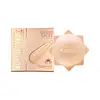What's inside
What's inside
 Key Ingredients
Key Ingredients

 Benefits
Benefits

 Concerns
Concerns

 Ingredients Side-by-side
Ingredients Side-by-side

Water
Skin ConditioningEthylhexyl Methoxycinnamate
UV AbsorberButyl Methoxydibenzoylmethane
UV AbsorberBenzophenone-3
UV AbsorberButylene Glycol
HumectantTitanium Dioxide
Cosmetic ColorantPhospholipids
Skin ConditioningPolyacrylate-13
Hydrogenated Polyisobutene
EmollientPolysorbate 20
EmulsifyingGlycerin
HumectantHydroxyethyl Acrylate/Sodium Acryloyldimethyl Taurate Copolymer
Emulsion StabilisingIsohexadecane
EmollientPolysorbate 60
EmulsifyingZinc Oxide
Cosmetic ColorantCyclopentasiloxane
EmollientNiacinamide
SmoothingAluminum Hydroxide
EmollientTalc
AbrasiveTriethoxycaprylylsilane
Paraffinum Liquidum
EmollientDimethicone
EmollientTocopheryl Acetate
AntioxidantAloe Barbadensis Extract
Skin ConditioningSodium Hyaluronate
HumectantPhenoxyethanol
PreservativeEthylhexylglycerin
Skin ConditioningCI 77499
Cosmetic ColorantCI 77491
Cosmetic ColorantCI 77492
Cosmetic ColorantDisodium EDTA
Water, Ethylhexyl Methoxycinnamate, Butyl Methoxydibenzoylmethane, Benzophenone-3, Butylene Glycol, Titanium Dioxide, Phospholipids, Polyacrylate-13, Hydrogenated Polyisobutene, Polysorbate 20, Glycerin, Hydroxyethyl Acrylate/Sodium Acryloyldimethyl Taurate Copolymer, Isohexadecane, Polysorbate 60, Zinc Oxide, Cyclopentasiloxane, Niacinamide, Aluminum Hydroxide, Talc, Triethoxycaprylylsilane, Paraffinum Liquidum, Dimethicone, Tocopheryl Acetate, Aloe Barbadensis Extract, Sodium Hyaluronate, Phenoxyethanol, Ethylhexylglycerin, CI 77499, CI 77491, CI 77492, Disodium EDTA
Ethylhexyl Methoxycinnamate
UV AbsorberDiethylamino Hydroxybenzoyl Hexyl Benzoate
UV FilterWater
Skin ConditioningButylene Glycol
HumectantPolymethylsilsesquioxane
Dicaprylyl Carbonate
EmollientStearalkonium Hectorite
Gel FormingPropylene Carbonate
SolventSclerotium Gum
Emulsion StabilisingSodium Polyacrylate
AbsorbentAloe Barbadensis Leaf Juice Powder
Skin ConditioningGlycerin
HumectantPanthenol
Skin ConditioningEscin
TonicRuscus Aculeatus Root Extract
AstringentAmmonium Glycyrrhizate
MaskingCentella Asiatica Extract
CleansingHydrolyzed Yeast Protein
Skin ConditioningCalendula Officinalis Flower Extract
MaskingParfum
MaskingPhenoxyethanol
PreservativeChlorphenesin
AntimicrobialEthylhexyl Methoxycinnamate, Diethylamino Hydroxybenzoyl Hexyl Benzoate, Water, Butylene Glycol, Polymethylsilsesquioxane, Dicaprylyl Carbonate, Stearalkonium Hectorite, Propylene Carbonate, Sclerotium Gum, Sodium Polyacrylate, Aloe Barbadensis Leaf Juice Powder, Glycerin, Panthenol, Escin, Ruscus Aculeatus Root Extract, Ammonium Glycyrrhizate, Centella Asiatica Extract, Hydrolyzed Yeast Protein, Calendula Officinalis Flower Extract, Parfum, Phenoxyethanol, Chlorphenesin
 Reviews
Reviews

Ingredients Explained
These ingredients are found in both products.
Ingredients higher up in an ingredient list are typically present in a larger amount.
Butylene Glycol (or BG) is used within cosmetic products for a few different reasons:
Overall, Butylene Glycol is a safe and well-rounded ingredient that works well with other ingredients.
Though this ingredient works well with most skin types, some people with sensitive skin may experience a reaction such as allergic rashes, closed comedones, or itchiness.
Learn more about Butylene GlycolEthylhexyl Methoxycinnamate is an organic compound that provides UVB protection. It often goes by the more common name of octinoxate. It is created from methoxycinnamic acid and 2-ethylhexanol.
Ethylhexyl Methoxycinnamate absorbs UVB rays with wavelengths between 280-320 nm. UV absorbers protect your skin by using chemical reactions to convert UV rays into heat and energy.
UVB (290-320 nm) rays emit more energy than UVA rays. They are capable of damaging DNA, causing sunburns and are thought to be linked to skin cancer.
The state of Hawaii has banned sunscreens containing octinoxate due to its potential impact on coral reefs. More research is needed to bridge gaps in this research. The European Union allows higher levels of octinoxate in sunscreens than the US and Australia.
Ethylhexyl Methoxycinnamate is oil soluble. It is not stable and may lose efficacy when exposed to sunlight.
Learn more about Ethylhexyl MethoxycinnamateGlycerin is already naturally found in your skin. It helps moisturize and protect your skin.
A study from 2016 found glycerin to be more effective as a humectant than AHAs and hyaluronic acid.
As a humectant, it helps the skin stay hydrated by pulling moisture to your skin. The low molecular weight of glycerin allows it to pull moisture into the deeper layers of your skin.
Hydrated skin improves your skin barrier; Your skin barrier helps protect against irritants and bacteria.
Glycerin has also been found to have antimicrobial and antiviral properties. Due to these properties, glycerin is often used in wound and burn treatments.
In cosmetics, glycerin is usually derived from plants such as soybean or palm. However, it can also be sourced from animals, such as tallow or animal fat.
This ingredient is organic, colorless, odorless, and non-toxic.
Glycerin is the name for this ingredient in American English. British English uses Glycerol/Glycerine.
Learn more about GlycerinPhenoxyethanol is a preservative that has germicide, antimicrobial, and aromatic properties. Studies show that phenoxyethanol can prevent microbial growth. By itself, it has a scent that is similar to that of a rose.
It's often used in formulations along with Caprylyl Glycol to preserve the shelf life of products.
Water. It's the most common cosmetic ingredient of all. You'll usually see it at the top of ingredient lists, meaning that it makes up the largest part of the product.
So why is it so popular? Water most often acts as a solvent - this means that it helps dissolve other ingredients into the formulation.
You'll also recognize water as that liquid we all need to stay alive. If you see this, drink a glass of water. Stay hydrated!
Learn more about Water